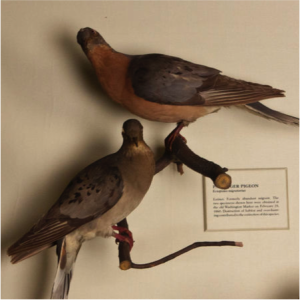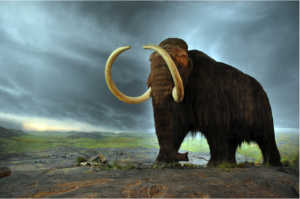As a Londoner, no flight of fancy is needed to place pigeons into my day-to-day surroundings. However, due to over hunting, this is not true the world over. The last passenger pigeon, once possibly the most abundant species of bird, became extinct in 1914, leaving a gap in American ecosystems. However, it has been proposed over recent years that ‘de-extinction’ of species such as the passenger pigeon and the woolly mammoth could be viable. It is suggested that extinct species could be recovered through three main techniques: either a copy of the DNA of an extinct species could be cloned, secondly a closely related living species could be selectively bred for traits found within the extinct species, or thirdly the DNA of closely related species could be engineered to mirror that of the extinct species. De-extinction has stirred up considerable controversy over its ecological and ethical feasibility, and its role within conservation. As with all such debates, there is merit on both sides…
In argument for investing in de-extinction, it is suggested the development of genetic engineering and cloning techniques necessary to perform de-extinction would advance other areas of research and have direct applications to endangered species. It is argued that genetic diversity could be restored to small populations and genetic defects removed through genetic engineering. Scientific understanding would also be extended through studying the development, ecology and behaviour of extinct species. Humans are thought to have a moral obligation to restore species that we drove to extinction back into ecosystems, though the equivalence of revived and extinct species is questioned. Some extinct species are thought to be ‘keystone’ species, and to have performed vital ecological functions within an ecosystem. One such species is the woolly mammoth, which maintained grassland habitats, preventing the release of greenhouse gasses from melting permafrost. Ecosystems that are currently threatened could therefore potentially be restored through the reintroduction of currently extinct species. Lastly, funding and enthusiasm for conservation could be increased by previously extinct species, especially through zoos and wildlife parks. De-extinction is seen as a positive conservation message in contrast to the negative messages often presented to the public, with de-extinct species as ‘umbrella species’ under which other species and habitats could be protected.
There are however, many issues raised by de-extinction too. The genetic engineering necessary to revive extinct species would require genetic information from multiple species. Judging from the public response to genetically modified food, GM species could cause widespread dissent. There are also animal welfare issues which arise from the process of de-extinction and animal exploitation for human ends could sit badly with animal rights activists. There are risks involved in reintroducing revived species as with reintroducing extant species, since interspecific interactions are difficult to predict in many cases. Alongside the habitat and food of these revived species, their ecosystem functions could also alter, resulting in invasive de-extinct species in some cases. Previously extinct species could carry pathogens or retroviruses that current species have not encountered, potentially causing significant mortality. Many conservationists are concerned that the prioritisation of de-extinction research could divert funding from management schemes to save extant species. The laws in place to regulate de-extinction are insufficient and questions remain as to whether revived species will be termed as endangered. Finally, some claim that de-extinction is intrinsically wrong, and beyond our remit as members of our ecosystems.
The proposition to revive species such as the passenger pigeon has ruffled many feathers within the scientific community. There is perhaps a case for placing such research on a back burner whilst focusing the limited funding and resources available upon saving extant species and their habitats. This does not rule out future research, but prioritises current conservation methods. However, perhaps more positive conservation policies are necessary – the issue is still open to debate…

